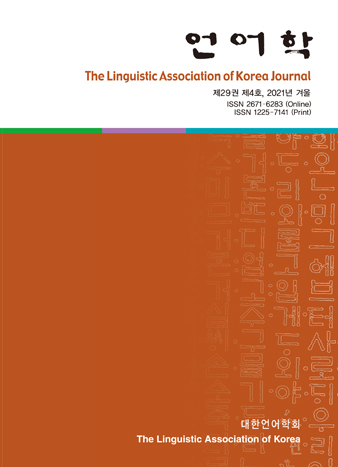대한언어학회 전자저널
29권 4호 (2021년 12월)
- 한국인 아동 학습자들의 영어 읽기 불안 분석: 불안의 양상과 요인을 중심으로
-
김보강 · 김정은
Pages : 1-20
Abstract
Kim, Bo-gang & Kim, Jeong-eun. (2021). Investigating the psychometric features of young language learners foreign language reading anxiety. The Linguistic Association of Korea Journal, 29(4), 1-20. This study investigated characteristics of foreign language (L2) reading anxiety in young learners who learn English by observing descriptive features of their L2 reading anxiety, and identifying components. A total of 70 young language learners aged between eight and thirteen participated in the study. Their English reading anxiety was assessed using the Foreign Language Reading Anxiety Scale (FLRAS) (Saito, Horwitz, & Garza, 1999). Descriptive statistics and a range of principal factor analyses were used to analyze their responses. Descriptive statistics found that child learners feel certain amount of anxiety on the activity of English reading itself, and also, feel anxiety from reading activities such as reading for details. Furthermore, the factor analysis found two major components comprising their reading anxiety: (1) anxiety in English, and (2) anxiety in reading. Pedagogical implications were discussed along with the research findings.
Keywords
# 영어 읽기 불안(English reading anxiety) # 외국어 읽기 불안 척도 (Foreign Language Reading Anxiety Scale: FLRAS) # 아동 영어 학습자 (young language learners) # 주성분 요인 분석(principal component factor analysis) # 탐색적 요인 분석(exploratory factor analysis)
References
- 박현진, 김정은. (2017). 외국인 학부생의 한국어 읽기 불안과 학업 성취도의 관계. 이중 언어학, 67, 129-160.
- 박현진. (2018). 한국어 읽기 불안도와 불안 요인의 상관성-중급 수준의 한국어 학습자 를 대상으로. 우리어문연구, 60, 361-393.
- 박현진. (2020). 초급 한국어 학습자의 읽기 불안 요인 연구. 우리어문연구, 66(1), 337-366.
- 박현진, 김정은. (2021). 불안 요인이 제2언어 학습자의 읽기 불안 증감에 미치는 차별적 영향. 외국어교육연구, 31(2), 277-299.
- 이다슴, 박성희. (2019). 베트남인 한국어 학습자의 읽기 불안 연구. 초·중급을 중심으로. 학습자중심교과교육연구, 19(18), 87-97.
- 이은진, 권연진. (2019). 한국어 학습자의 읽기 불안 양상에 관한 연구. 학습자중심교과 교육연구, 19(11), 501-520.
- 정유경, 김현옥. (2010). 중·고등학교 영어 학습자의 영어 읽기 불안과 영어 학습 불안. 영어학, 10(1),105-129.
- Aida, Y. (1994). Examination of Horwitz, Horwitz, and Cope’s construct of foreign language anxiety: The case of students of Japanese. Mordern Language Journal, 78, 155-168.
- Brantmeier, C. (2005). Anxiety about L2 reading or L2 reading tasks? A study with advanced language learners. The Reading Matrix, 5-2, 67-85.
- Buckmaster, R. (2005). Reading and reading skills: Exploiting texts to the full. Modern English Teacher, 14-2, 38-41.
- Clément, R. (1987). Second language proficiency and acculturation: An investigation of the effects of language status and individual charcateristics. Jorunal of Language and Social Psychology, 5, 271-290.
- Cohen, S. (1986). Contrasting the Hassles Scale and the Perceived Stress Scale: Who’s really measuring appraised stress? American Psycologist, 41(6), 716-718.
- Day, R. R., & Bamford, J. (1988). Extensive reading in the second language classroom. Cambridge: Cambridge University Press.
- Hair, J. F., Black, W. C., Babin, B. J., & Anderson, R. E. (2010). Multivariate data analysis: A global perspective. (7th ed.). Upper Saddle River, NJ: Pearson Education.
- Horwitz, E., Horwitz, M., & Cope, J. A. (1986). Foreign language classroom anxiety. Modern Language Journal, 70, 125-132.
- Lee, J. F. (1999). Clashes in L2 reading: Research versus practice and readers’ miscomceptions. In D. J. Young (Ed.), Affect in foreign language and second language learning: A practical guide to creating a low-anxiety classroom atmosphere (pp. 49-63). New York: McGraw-Hill.
- MacIntyre, P. D., & Gardner, R. C. (1989). Anxiety and second language learning: Toward a theoratical clarification. Language Learning, 39-2, 251-275.
- Mallow, J. V. (1981). Science anxiety: Fear of science and how to overcome it. New York: Thomond Press.
- Matsuda, S., & Gobel, P. (2004). Anxiety and predictors of performance in the foreign language classroom. System, 32, 21-36.
- Richard, F. C., & Woolfolk, R. L. (1980). Mathematics anxiety. In I. G. Sarason (Ed.), Test anxiety: Theory, research, and applications (pp. 271-288). Mahwah, New Jersey: Lawrence Erlbaum Associates.
- Saito, Y., Garza, T., & Horwitz, E. K. (1999). Foreign language reading anxiety. The Modern Language Journal, 83, 202-218.
- Sellers, V. D. (2000). Anxiety and reading comprehension in Spanish as a foreign language. Foreign Language Annals, 33(5), 512-521.
- Tobias, S. (1979). Anxiety research in educational psychology. Journal of Educaional Psychology, 71, 573-582.
- Zbornik, J. J., & Wallbrown, F. H. (1991). The development and validation of a scale to measure reading anxiety. Reading Improvement, 28(1), 2-13.
- Zhao, A., Dynia, J., & Guo, Y. (2013). Foreign language reading anxiety: Chinese as a foreign language in the United States. The Modern Language Journal, 97-3, 764-778.
- Wigfield, A., & Guthrie, J. T. (1997). Relations of children’s motivation for reading to the amount and breadth of their reading. Journal of Educational Psychology, 89(2), 420-432.
